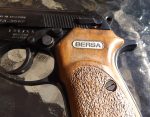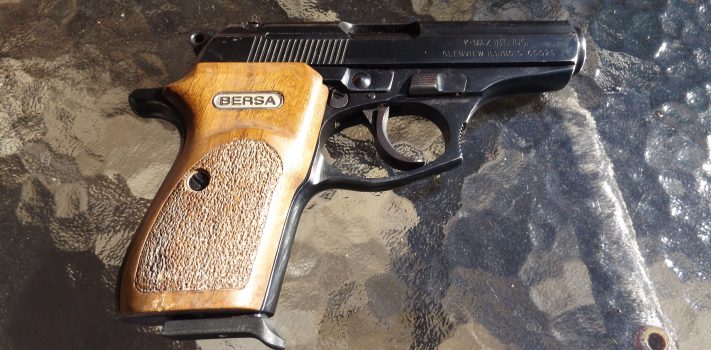This particular pistol, the Bersa Model 383, has been in the family for about 25-years, maybe even longer. It was my wife’s everyday carry gun, for a lot of years. She just likes the way it feels in her hand for some reason. It was a step-up from her little .22 LR pistol that was never reliable, and of course, the .22 LR is a pitiful stopper when used for self-defense. It took a lot of years before my wife gave up the Versa 383 and started carrying a Glock 19, with a laser on it. It was just recently, that she started carrying a Taurus G2c. And before that, she had the Taurus PT111. I offered her a Taurus G3c, but she preferred the G2c for some reason.
The .380 ACP round isn’t my first choice in a self-defense handgun, although with the new Ruger .380 MAX, that holds 10+ or 12+1 rounds of .380 ACP, my thinking has changed – that’s a lot of ammo in a small handgun – a very small handgun. Still, anything in .380 ACP is not my first choice in a self-defense handgun.
My wife and I have easily put at least 2,000-rounds of .380 ACP through this Bersa Model 383 over the years – always in target practice. However, for the past dozen years or more, the Bersa has sat unused, There are just too many other firearms that we enjoy shooting more than the Bersa.
The 383 is similar in size to the Walther PPK/s If that helps you understand the size – this size is considered “compact” by many gun makers. The gun has a 3.5-inch barrel, and weighs in at about 26-ounces. It has a steel frame. The current Bersa that is called the Thunder 380 has an aluminum frame is about half a pound lighter in weight. The 383 is blued – nicely done I might add. And has 3-dot white sights – a very nice touch. The grips are wooden, while on the new models, they are polymer. This is a single action/double action pistol – with the hammer down, the first shot is a long and VERY heavy pull. But the single-action trigger after that first shot isn’t terribly bad.
We have a single-side de-cocker and it is stiff to apply and take off safe – ugh! The gun can be carried with the de-cocker in the “on” but it is slow and difficult to push it up, so you can fire the gun. Now, when it comes to loading the gun – the chamber, that is – the slide is very heavy to pull back, so you can chamber a round.
The 383 is a fixed barrel set-up – and when you fire the gun, the barrel doesn’t move at all – and this makes recoil a lot harder than it should be. The gun came with one 8-round magazine but we found some more. Unfortunately, one of the magazines is an after-market number, and it has never been reliable – so we don’t use it. With its fixed barrel, the gun is more than a little bit “snappy” when you pull the trigger.
 The front strap is completely smooth. However the front of the trigger guard is serrated, if you shoot with that type of hold on the gun – it was popular at one time – but not any longer. There is also an extended “beaver tail” on the frame – nice touch. The magazine release – it isn’t behind the trigger guard, it sits above the trigger guard – making it difficult to reach for a quick reload. The slide release/lock is just above the mag release, and it takes two men and a small boy to press down on it to release the slide.
The front strap is completely smooth. However the front of the trigger guard is serrated, if you shoot with that type of hold on the gun – it was popular at one time – but not any longer. There is also an extended “beaver tail” on the frame – nice touch. The magazine release – it isn’t behind the trigger guard, it sits above the trigger guard – making it difficult to reach for a quick reload. The slide release/lock is just above the mag release, and it takes two men and a small boy to press down on it to release the slide.
My Bersa was imported by a company called K-Max International, and the gun was made in Argentina. They often produce some outstanding firearms down there in South America.
Besides malfunctions with the after-market magazine, we also had problems with the Blazer aluminum-cased .380 ACP ammo. Quite often, the extractor would slip off the fired case, tying the gun up. Other than those two problems — and I would never carry Blazer aluminum-cased ammo, nor use that after-market magazine for self-defense — the gun has run without any other problems.
No matter what type of gun you have, sooner or later, you will find some kind of ammo that won’t function in it. I stopped purchasing the aluminum-cased ammo many years ago. The same goes for steel-cased ammo. Steel-cased ammo – no matter how hard I’ve tried, the lacquer coated steel cases – were tough to load into Glock 9mm magazines – never could get the total amount of rounds in a Glock – and I also had feeding and ejection problems with that ammo. We don’t even use steel-cased ammo for target practice.
My Tests
 To prepare this article, I decided to bench-rest this little Bersa, to see what it could really do. We already knew the gun was accurate and reliable, however, we never benched it. I set the target out at 20-yards, and using several types of Black Hills Ammunition ammo – I was getting groups right at 3-inches and that’s outstanding for a compact .380 ACP pistol. We had the Black Hills 60-gr HonelyBadger all copper load, 95-gr JHP and 100-gr FMJ loads on hand. And, they all gave me pretty much the same accuracy results – about 3-inches for 5-shots. Again, there were no malfunctions of any type. limited my shooting to only 100-rounds because of the ammo drought we are still in. These days, I don’t shoot much for my articles. Ammo is too precious to just burn up, and I don’t shoot much .380 ACP at all, each year.
To prepare this article, I decided to bench-rest this little Bersa, to see what it could really do. We already knew the gun was accurate and reliable, however, we never benched it. I set the target out at 20-yards, and using several types of Black Hills Ammunition ammo – I was getting groups right at 3-inches and that’s outstanding for a compact .380 ACP pistol. We had the Black Hills 60-gr HonelyBadger all copper load, 95-gr JHP and 100-gr FMJ loads on hand. And, they all gave me pretty much the same accuracy results – about 3-inches for 5-shots. Again, there were no malfunctions of any type. limited my shooting to only 100-rounds because of the ammo drought we are still in. These days, I don’t shoot much for my articles. Ammo is too precious to just burn up, and I don’t shoot much .380 ACP at all, each year.
I’ve never carried this Bersa 383 – my wife carried it for several years in her CCW purse, and she still likes the way it feels in her hand. However, after shooting it this time, she MUCH prefers her Taurus G2c and her Glock 19 over this Bersa. She commented on how much more this Bersa “kicked” compared to the 9mm handguns we shot.
I taught NRA Basic Handgun, Basic Rifle, and Personal Protection classes for 25-years – and “no” I no longer teach firearms classes. Many students came to classes without any type of firearms to train with. I usually took quite a few different handguns with me, so they could try out different calibers and type of guns. Of course, the Bersa, went with me quite often – when .380 ACP ammo was cheaper than it is today – and most of the students commented on how nice the gun felt in their hand. A few – very few – said it was too thick for their hand. And, they all said it “kicked” too much – however, they all shot it extremely well. Go figure.
The box this gun came in, has a price of $225 marked on it – though I don’t think we paid that much for it. The current Bersa .380 Thunder has a retail price of $349 on it – is it a deal at that price? No, I don’t think so, not when you can purchase better guns, from some of the big-name gun companies, for that price – or less. Plus, you can get a gun that is smaller, and holds more rounds and is easier to shoot.
Now, with all of that said, if you happen to run across a used Bersa 383, at a fair price, then pick it up – if nothing else, it is a fun gun to shoot – however, be advised that, .380 ACP ammo is presently a lot more expensive than 9mm ammo is – any place you shop. Still, this little Bersa is fun to shoot, well-made, and can stand up to years of shooting pleasure.
If you pick up a Bersa, make sure you practice with it – a lot! So, you get used to the heavy first-round trigger pull, and heavier recoil. By no means is the recoil punishing, its just a lot more than you’d think it would. There are not a lot of good holsters available for the Bersa, so you may get stuck with some generic ballistic nylon holster if you want to carry this piece on a regular basis.
If possible, see if you can find a gun shop that has an indoor range, and if they have a Bersa in .380 ACP will allow you to rent the gun and shoot it, before you purchase it. A tiny gun shop in Chicago Ridge, Illinois that I used to haunt on a regular basis, actually had two ranges, and you could rent used guns to shoot – for a small fee – along with the range fee – to see if you liked it before buying it. And, if they thought you were dead serious about purchasing a brand-new gun, they would also allow you to test it before you purchased it.
Sadly, these days, there aren’t a lot of indoor gun ranges in the big cities any longer – I don’t think I’ve shot on an indoor range for more than 35 years now. I prefer shooting up in the mountains, and there are several really good areas up there, where folks go to shoot on a regular basis.










